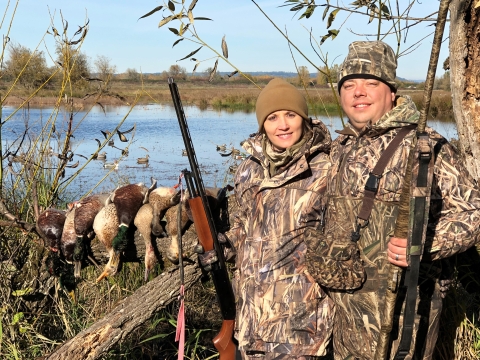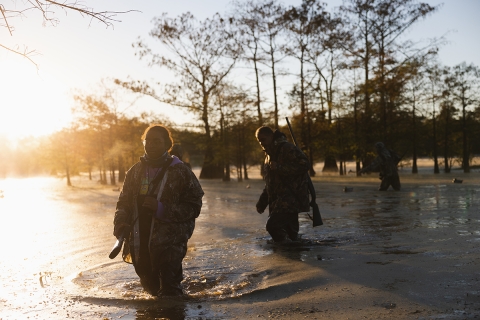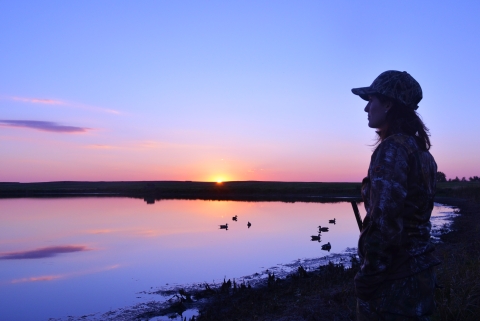More than 1 million people participate in waterfowl hunting every year. So how do so many people enjoy hunting waterfowl and other migratory birds when they are a national treasure protected under the Migratory Bird Treaty Act? And how do we ensure that waterfowl populations thrive and can sustain the harvest?
How does it all work?
It begins with four international treaties that most people don’t even know about. The U.S. has four international conservation treaties, commonly referred to as the Migratory Bird Conventions. We have a treaty with Canada, Mexico, Japan, and Russia, all of which were originally created to ensure the sustainability of populations of all protected migratory bird species.
The Migratory Bird Treaty Act of 1918 (MBTA) implements those four treaties and prohibits the take – including killing, capturing, selling, possession, trading, and transport – of protected migratory bird species without authorization by the Department of the Interior U.S. Fish and Wildlife Service (Service).
Thus, it is the Secretary of the Department of the Interior that actually permits the take, in this case that is the hunting of migratory birds, under the MBTA. Important to this decision is that the hunting season is closed until the Secretary determines that the status of game bird species is sufficient to allow hunting. Therefore, the Service, on behalf of the Secretary of the Interior, creates regulations each year using data on the status of game birds to allow the hunting of certain species of migratory game birds.
The Regulations
The purpose of making annual hunting regulations is to keep the harvest of game birds at levels compatible with a population's ability to maintain itself. There are two regulatory tools that we use to manage this process: the framework regulations and special regulations.
Federal Framework Regulations
Framework regulations are the main foundation of annual regulations and consist of the boundary dates for opening and closing seasons, season length, daily bag and possession limits, and shooting hours.
In order to ensure these regulations are based on the best available and mostly timely scientific information, we use data from annual monitoring programs to determine the birds’ status, and ultimately if hunting can be sustained. Specifically, we use the results of annual survey and monitoring programs including bird banding, waterfowl breeding population and habitat surveys, and harvest surveys, as the basis for establishing the annual federal frameworks.
This strategy was developed cooperatively with the states in each Flyway and across all the Flyways (Atlantic, Mississippi, Central and Pacific) to manage our shared migratory bird resources. These frameworks often differ by Flyway depending on population status, number of hunters, projected harvest numbers, etc. Our objective is essentially to provide maximum hunting opportunity over the long-term while sustaining waterfowl populations into the future.
Season Lengths
The earliest (September 1) and latest (March 10) dates allowed for hunting are set by the Migratory Bird Conventions referenced at the beginning of this story. Framework dates, which are the annual dates selected by the Service for hunting, vary for different groups of migratory game birds. Annual framework dates for most regular waterfowl seasons are from the end of September to the end of January for ducks, and mid-February for geese.
Under the MBTA, season lengths may not exceed 107 days. The MBTA and related implementing regulations restrict when migratory bird hunting can occur during the year. The opening framework dates for the regular duck season cannot be earlier than the Saturday closest to September 24th and the closing date cannot be after January 31st. Why? Because hunting ducks after January 31st could have impacts on hen behavior and harvest in February is likely to have negative impacts on breeding duck population sizes in the spring. That could impact subsequent hunting seasons and reduce the overall opportunity for all hunters.
Season lengths for ducks vary by Flyway, with seasons being the longest in the Pacific Flyway and the shortest in the Atlantic and Mississippi Flyways, reflecting differences in the abundance of birds, number of hunters, migration patterns, and other factors. Once the federal frameworks are set, then the states have the option of selecting their seasons as long as they are within the federal frameworks (i.e., no more than 60 days in the Mississippi Flyway and 74 days in the Central Flyway when liberal seasons are allowed).
Most states select their hunting season to maximize their duck harvest within these frameworks. States always have the right to be more restrictive than the established federal frameworks.
Season lengths, bag limits, and to a lesser extent framework dates are selected and changed based on changes in bird abundance and habitat conditions.
Bag Limit
The daily bag limit is the number of birds of a species or group that can be harvested by an individual hunter in a single day. The daily bag limit is based on the harvest pressure that the species or group can sustain. As with season lengths, Flyway differences in daily bag limits also exist; daily bag limits for ducks generally are more liberal in the Pacific Flyway and become more restrictive as one moves east across the flyways, for the same reasons that the season lengths differ.
There will always be differences in duck abundance and hunter success across all the states in the Flyway. Habitat quantity and quality, timing of migration, weather, food abundance, hunting pressure, and climate change climate change
Climate change includes both global warming driven by human-induced emissions of greenhouse gases and the resulting large-scale shifts in weather patterns. Though there have been previous periods of climatic change, since the mid-20th century humans have had an unprecedented impact on Earth's climate system and caused change on a global scale.
Learn more about climate change all impact hunter success in each state.
Shooting Hours and Possession Limits
Shooting hours and possession limits are rarely altered. Since 1918, one-half hour before sunrise to sunset has been the traditional shooting hours. Possession limits are set by the Flyways and are the total number of birds a hunter can have in their possession, usually 2-3 times the daily bag limit.
Special Regulations
Special regulations are those used to either increase or decrease hunting pressure on certain species or groups, or to distribute hunting opportunities equitably across regional scales. These consist of split seasons, zones, special seasons, and special management units. States have been allowed to divide their total hunting days (i.e., "split" their season) for some species and groups of birds into two or sometimes three nonconsecutive segments in order to take advantage of species-specific peaks of abundance. Zoning is the establishment of independent seasons in two or more areas (zones) within a state for the purpose of providing more equitable distribution of harvest opportunity for hunters throughout the state. Generally, special seasons focus on those species considered to be more lightly utilized than others. Special season hunting days are usually, although not always, in addition to the regular season, but the total number of days hunted in both regular and special seasons combined cannot exceed the 107-day limit as required by the MBTA. Special seasons currently exist for some teal, wood duck, and resident Canada goose populations.
Who Makes These Decisions?
Migratory game bird management in the United States is a cooperative effort of state and federal governments. The U.S. and Canada are divided into four administrative Flyways, and each flyway has a Flyway Council (Councils) consisting of representatives from state and provincial wildlife management agencies, who work together and with the Service and the Canadian Wildlife Service to manage migratory birds in their flyway.
The Councils are advised by flyway technical committees consisting of state and provincial biologists. These technical committees evaluate species and population status, harvest, and hunter-participation data during the development of the Council recommendations. Supported by those biological evaluations, the Councils (U.S. members only) recommend hunting regulations to the Service for waterfowl and for most migratory shore and upland game birds.
The Service's Migratory Bird Program then evaluates the Council recommendations, considering species status and biology, cumulative effects of regulations, and existing regulatory policy. The Service then develops their recommendations, which may support Council recommendations or may differ from them, based on their assessment of likely impacts of the proposed regulations.
The Service and the Councils then present their recommendations to the Service's Regulations Committee, which consists of members of the Service Directorate. The Service’s Regulations Committee considers both the Council and Migratory Bird Program recommendations, then forwards its decisions on annual migratory bird hunting regulations to the Service Director and the Assistant Secretary of the Interior for Fish, Wildlife, and Parks for approval.
How are the Regulations Set for Everyone to Follow?
First, the proposed regulations are published in the Federal Register and are open for public comment. After the comment period, then the final regulations are developed, which are also then published in the Federal Register. Then the individual states select their seasons within the federal guidelines.
Additional Links
Migratory Bird Hunting Activity and Harvest Reports | U.S. Fish & Wildlife Service (fws.gov)
Migratory Bird Hunting Regulations | U.S. Fish & Wildlife Service (fws.gov)
Information for Waterfowl Hunters | U.S. Fish & Wildlife Service (fws.gov)





